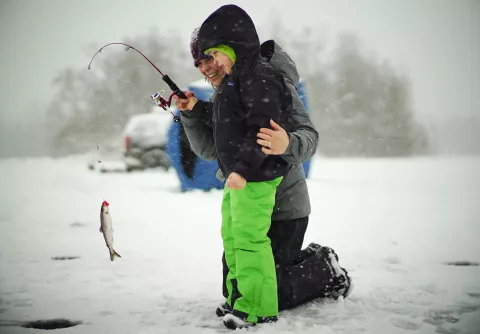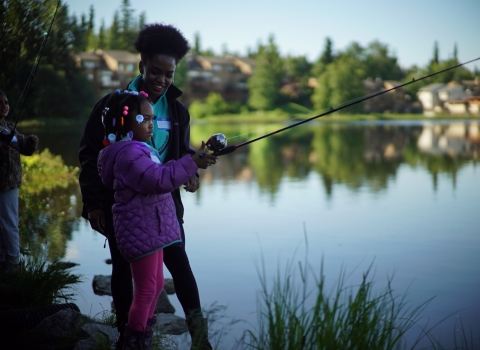Ice fishing season is here, and whether you're chasing walleye, perch, northern pike, or trout, protecting your favorite fishing spots is just as important as landing the big one. Invasive species and diseases don’t take the winter off. They can spread through bait, gear, and even frozen water, threatening fish populations and water quality.
Here’s how you can keep your gear clean, your catch safe, and your fishing holes healthy all winter long
1. Trash Your Bait
VHS isn’t just an old-timey tape format that tried our patience, it’s also a virus (Viral Hemorrhagic Septicemia) that is deadly to fish. Do walleye a favor and don't hit play on this outdated disaster by using risky bait. Even frozen bait can carry invasive species invasive species
An invasive species is any plant or animal that has spread or been introduced into a new area where they are, or could, cause harm to the environment, economy, or human, animal, or plant health. Their unwelcome presence can destroy ecosystems and cost millions of dollars.
Learn more about invasive species like zebra mussels and fish diseases that spread when the ice melts.
Better bait practices:
- Only use commercial bait at one body of water.
- Toss unused bait in the trash, not on the ice or in the water.
- Never move bait between bodies of water. Invasives love to hitch a ride.
2. Clean Off Your Gear Before Leaving
If you wouldn’t track it into your truck, don’t track it into another lake! Ice augers, sleds, and boots can carry tiny invasive hitchhikers like zebra mussels and invasive plants, even in freezing temperatures. If you’re targeting walleye and pike in deep water one day and switching to a shallower spot for perch the next, make sure you’re not bringing more than your gear.
How to clean ice fishing gear quickly:
- Brush off mud, ice, and plant debris from boots, sleds, and augers.
- Wipe down shelters, rods, and gear after every trip.
- Let everything dry completely before heading to a new body of water.
3. Drain Water from Your Sleds, Buckets & Coolers
Moving water between fishing spots can spread fish diseases and invasive species. If you’re keeping walleye, perch, or trout, use fresh ice instead of lake or river water to store them.
Better storage options:
- Always drain your livewell, cooler, and ice shack before leaving.
- Use clean ice or dry storage for your catch.
Never transport water between lakes— it is one of the easiest ways for invasives to spread.
Before heading out, always check local ice conditions, fishing regulations, and safety guidelines. Recommended Ice Thickness for Ice Fishing:
- 4 inches for walking
- 5–7 inches for snowmobiles
- 8–12 inches for vehicles
To protect walleye, perch, pike, and trout fishing for years to come, follow these practices:
- CLEAN your gear before leaving the water
- DRAIN water from sleds & coolers
- DRY everything before your next trip
- TRASH bait, don’t dump it
Where Do Your Fish Come From?
Some of the fish you catch while ice fishing—including trout and walleye—might come from the National Fish Hatchery System. For more than 150 years, national fish hatcheries have helped restore fish populations, support recreational fishing, and keep waters stocked for anglers like you. Find a hatchery near you and see how we raise fish for the future.
More Ice Fishing Tips & Resources
Want to learn more about ice fishing safety, gear, and best practices? Check out your state’s fishing regulations for local rules on bait use, ice fishing shelters, and invasive species prevention.







